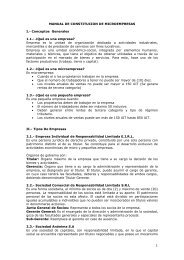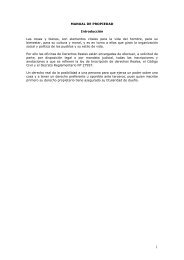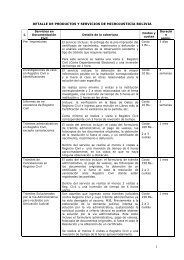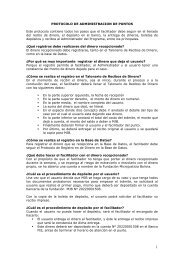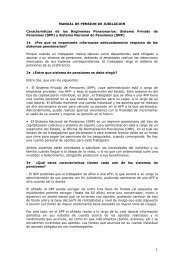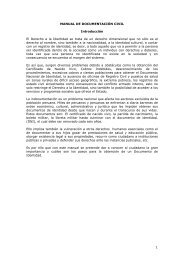ICISS report - International Coalition for the Responsibility to Protect
ICISS report - International Coalition for the Responsibility to Protect
ICISS report - International Coalition for the Responsibility to Protect
Create successful ePaper yourself
Turn your PDF publications into a flip-book with our unique Google optimized e-Paper software.
The <strong>Responsibility</strong> <strong>to</strong> <strong>Protect</strong> 50<br />
6.15 It is a necessary corollary of this perception of <strong>the</strong> Security Council’s role that it be<br />
established as a matter of practice that all proposals <strong>for</strong> military intervention be <strong>for</strong>mally<br />
brought be<strong>for</strong>e it. The Commission accordingly is agreed that:<br />
❏ Security Council authorization must in all cases be sought prior <strong>to</strong> any military<br />
intervention action being carried out. Those calling <strong>for</strong> an intervention must<br />
<strong>for</strong>mally request such authorization, or have <strong>the</strong> Council raise <strong>the</strong> matter on its<br />
own initiative, or have <strong>the</strong> Secretary-General raise it under Article 99 of <strong>the</strong> UN<br />
Charter; and<br />
❏ The Security Council should deal promptly with any request <strong>for</strong> authority <strong>to</strong><br />
intervene where <strong>the</strong>re are allegations of large scale loss of human life or ethnic<br />
cleansing; it should in this context seek adequate verification of facts or conditions<br />
on <strong>the</strong> ground that might support a military intervention.<br />
Legal Capacity<br />
6.16 Article 42 authorizes <strong>the</strong> Security Council, in <strong>the</strong> event that non-military measures<br />
prove “inadequate,” <strong>to</strong> decide upon military measures “as may be necessary” “<strong>to</strong> maintain<br />
or res<strong>to</strong>re international peace and security.” Although <strong>the</strong>se powers were interpreted<br />
narrowly during <strong>the</strong> Cold War, since <strong>the</strong>n <strong>the</strong> Security Council has taken a very expansive<br />
view as <strong>to</strong> what constitutes “international peace and security” <strong>for</strong> this purpose, and in<br />
practice an authorization by <strong>the</strong> Security Council has almost invariably been universally<br />
accepted as conferring international legality on an action. The cross-border implications of<br />
a number of <strong>the</strong> interventions authorized in <strong>the</strong> post-Cold War years have not been in<br />
doubt. But <strong>the</strong>re is equally no doubt that in o<strong>the</strong>r cases – Somalia most prominent among<br />
<strong>the</strong>m – <strong>the</strong> cross-border implications were less evident.<br />
6.17 It is arguable that what <strong>the</strong> Security Council has really been doing in <strong>the</strong>se cases is<br />
giving credence <strong>to</strong> what we described in Chapter 2 as <strong>the</strong> emerging guiding principle of <strong>the</strong><br />
“responsibility <strong>to</strong> protect,” a principle grounded in a miscellany of legal foundations (human<br />
rights treaty provisions, <strong>the</strong> Genocide Convention, Geneva Conventions, <strong>International</strong><br />
Criminal Court statute and <strong>the</strong> like), growing state practice – and <strong>the</strong> Security Council’s own<br />
practice. If such a reliance continues in <strong>the</strong> future, it may eventually be that a new rule of<br />
cus<strong>to</strong>mary international law <strong>to</strong> this effect comes <strong>to</strong> be recognized, but as we have already<br />
acknowledged it would be quite premature <strong>to</strong> make any claim about <strong>the</strong> existence now of<br />
such a rule.<br />
6.18 An important unresolved <strong>the</strong>oretical question is whe<strong>the</strong>r <strong>the</strong> Security Council can in<br />
fact exceed its own authority by violating <strong>the</strong> constitutional restraints embedded in <strong>the</strong><br />
Charter, particularly <strong>the</strong> inhibition in Article 2.7. This issue has only been tangentially<br />
considered by <strong>the</strong> <strong>International</strong> Court of Justice (ICJ) in <strong>the</strong> Lockerbie case, with <strong>the</strong> 1998<br />
decision on preliminary objections affirming that <strong>the</strong> Security Council is bound by <strong>the</strong><br />
Charter. But <strong>the</strong> issue seems destined <strong>to</strong> remain a <strong>the</strong>oretical one, since <strong>the</strong>re is no provision<br />
<strong>for</strong> judicial review of Security Council decisions, and <strong>the</strong>re<strong>for</strong>e no way that a dispute over<br />
Charter interpretation can be resolved. It appears that <strong>the</strong> Council will continue <strong>to</strong> have<br />
considerable latitude <strong>to</strong> define <strong>the</strong> scope of what constitutes a threat <strong>to</strong> international peace<br />
and security.



